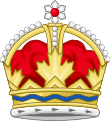| This article is part of a series on |
| Conservatism in Canada |
|---|
 |
 |
|---|
Conservatism in Canada (French: conservatisme) is generally considered a movement which is primarily represented by the modern-day Conservative Party of Canada in federal party politics, as well as various centre-right and right-wing parties at the provincial level. Far-right politics have never been a prominent force in Canadian society.[1][2] The first party which called itself "Conservative" in what would become Canada was elected in the Province of Canada election of 1854.
Canadian conservative ideology has its origins in British Toryism, but over time has been influenced by American conservatism.[3][4] Stemming from the resettlement of United Empire Loyalists after the American Revolutionary War with traditionalist conservative views alongside pro-market liberalism ideals,[5][3] is the reason that Canadian conservatives generally prefer the Westminster system of government.[6][3]
Originally, Canadian conservatism tended to be traditionalist. Conservative governments in Canada, such as those of John A. Macdonald, Robert Borden, R. B. Bennett, and John Diefenbaker, were known for supporting an active role for the government in the economy and the creation of government-operated businesses (early Crown Corporations such as the Canadian National Railway) to develop and protect Canadian industries, protectionist programs such as the National Policy. Canadian conservatism thus mirrored British Conservatism in its values and economic and political outlooks. Canadian conservatives have generally favored the continuation of old political institutions and the preservation of strong ties to the monarchy.
In the latter half of the 20th-century, Canadian conservatism embraced neoliberal economic policies which included free trade, the seeking of balanced budgets, and the support of the privatizations of Crown Corporations which were claimed to be better provided for by the private sector. During this time, division arose between the conservatives in Eastern and Western Canada because Western conservatives perceived Canada's federal parliament as being dominated by Eastern interests. This Western alienation led to the creation of the Reform Party of Canada as a Western-based populist protest party promoting constitutional reform to balance the regions' interests and sought to expand into the East—especially in Ontario—to displace the Progressive Conservative Party of Canada. While the PCs and Reform had some similar economic policies, Reformers wanted deeper cuts to government services than the PCs and Reformers had strong social conservative stances whereas the PCs were more neutral on controversial social issues.
The PCs faced an unprecedented collapse in the 1993 federal election and Reform surpassed the PCs as the largest conservative party in Canada's parliament. After several elections of neither party making significant gains, the two parties agreed to merge into the new Conservative Party of Canada in 2003. Meanwhile, although Quebec delivered few seats to conservative parties in federal elections from 1993 on, conservative themes were influential in Quebec provincial politics.
- ^ Ambrose, Emma; Mudde, Cas (2015). "Canadian Multiculturalism and the Absence of the Far Right". Nationalism and Ethnic Politics. 21 (2): 213–236. doi:10.1080/13537113.2015.1032033. S2CID 145773856.
- ^ Blake, Raymond B. (2 January 2024). "Locating the Right in Canadian Political History". American Review of Canadian Studies. 54 (1). Informa UK Limited: 1–8. doi:10.1080/02722011.2024.2326264. ISSN 0272-2011.
Social conservatives and the extreme right have had limited success designing the direction and policies of Canada's right-wing political parties.
- ^ a b c Seymour Martin Lipset (2013). Continental Divide: The Values and Institutions of the United States and Canada. Routledge. pp. 48–52. ISBN 978-1-136-63981-4.
- ^ James H. Marsh (1999). The Canadian Encyclopedia. The Canadian Encyclopedia. pp. 547–49. ISBN 978-0-7710-2099-5.
- ^ James Bickerton; Alain-G. Gagnon (2014). Canadian Politics: Sixth Edition. University of Toronto Press. p. 270. ISBN 978-1-4426-0703-3.
- ^ Cite error: The named reference
vidwas invoked but never defined (see the help page).
